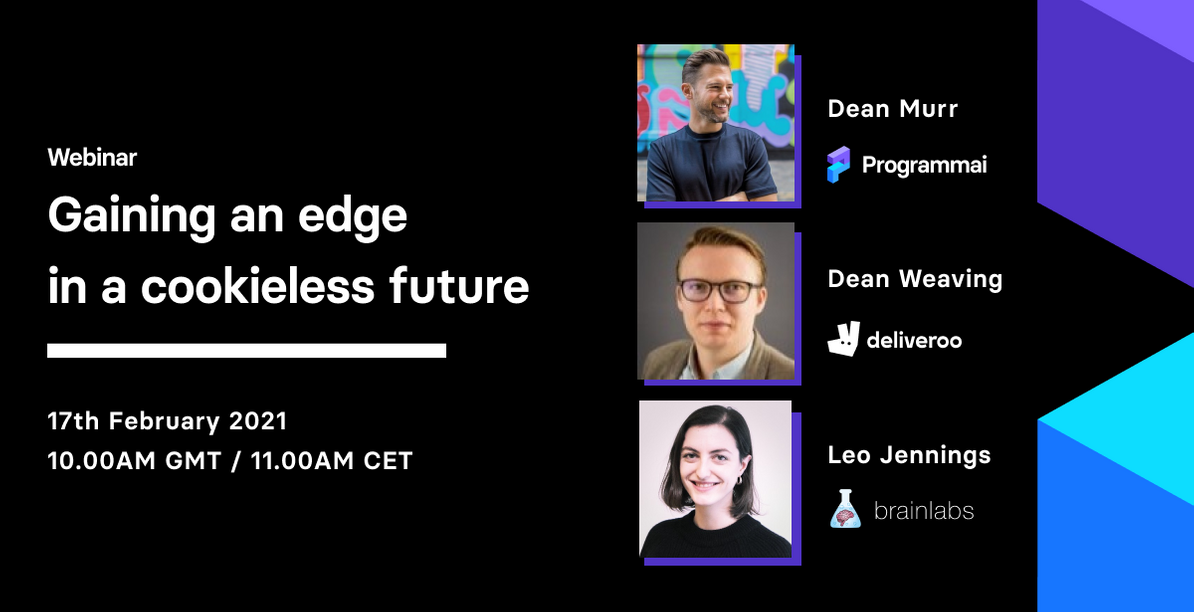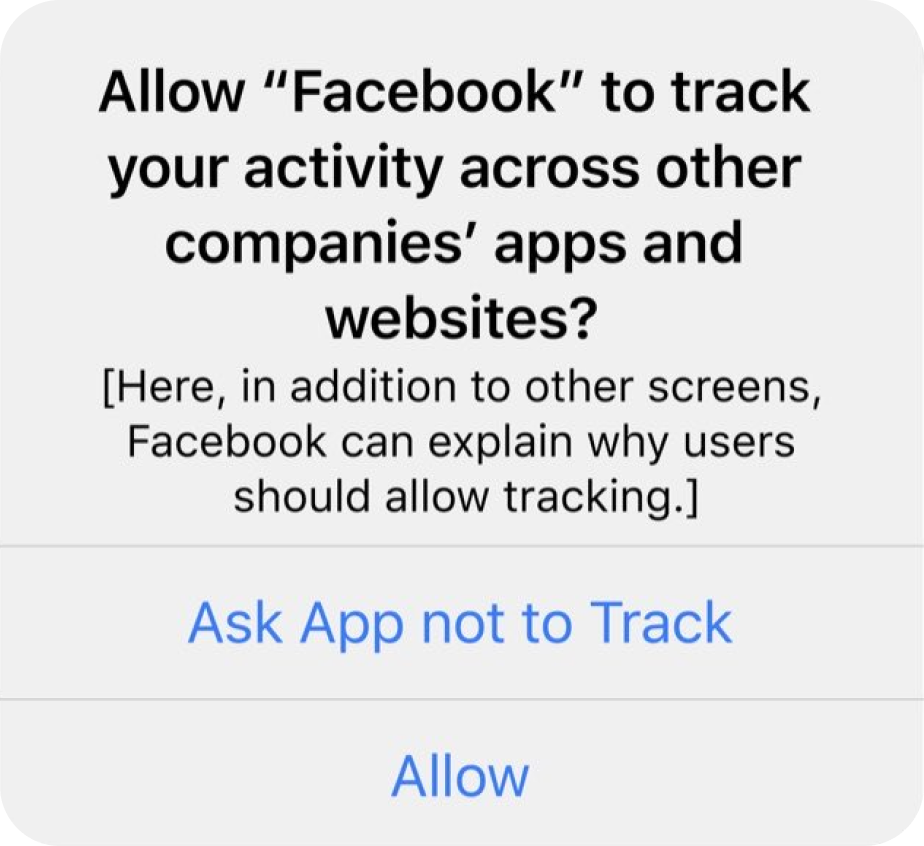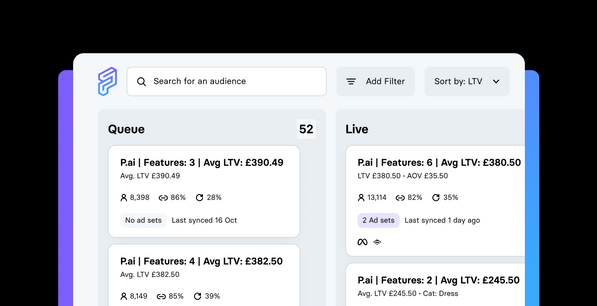No matter where you look, our ecosystem is built on third party cookies. And that’s changing – fast.
Now that iOS 14 is here, users will be able to choose whether they want a tech company like Facebook to track them around the internet. It’s a direct challenge to Facebook’s revenue, and the advertisers who rely on it. With third party cookies also on their way out, any kind of tracking or measurement will soon rely on first party data.
That’s why we brought together Deliveroo and Brainlabs to hear how they’re gaining an edge in a cookieless future.
Enter Leo Jennings, SVP EMEA at Brainlabs. Dean Weaving, Global Head of Display, Video and Social at Deliveroo (Deliveroo Dean). And Dean Murr, Programmai’s CEO and Founder (Programmai Dean).
Watch the webinar in full here.
Three key takeaways:
- Invest in your analytics and data science, whether in-house or through a partner. Unify your first party data strategy, break down any existing silos between your CRM and digital marketing teams and make sure that your data insights are actionable.
- Test consistently. Tie experiments back to revenue and/or a clear KPI. Look to scale everything across products and/or markets.
- Respond to what’s happening in society. Advertising goes viral when it feels authentic and taps into an emotion.
The challenges
Murr: How are the changes impacting Deliveroo?
Weaving: The phase-out of third party cookies affects everything we do. Because it’s going to have such an impact on our business, the more we understand it, the better prepared we’ll be.
That’s what I’m telling my friends and colleagues.
We’re leaning on the Facebooks and Googles of this world to understand the changes. To bring us another view, we’re also bringing on consultants and experts.
Murr: Leo, you’ve got a lateral view of the landscape from your marketing agency Brainlabs. How are your clients reacting to the news?
Jennings: With horror. We have the full spectrum of clients – from businesses with advanced data strategies to others who are taking early steps. No matter how you look at it, the impact is huge. Some of our clients are set to lose up to 70% of their recorded conversions.
One of the big challenges lies in the relationship between the CRM and digital marketing teams. Often, they’re built separately and clients struggle to sync them. The CRM team tends to deal with email and have all the first party data, while the digital marketing team relies on cookies because they’re easy to set up and means they can move faster.
We need to make sure that the CRM and digital marketing teams are working together. Data needs to be moving between them so that we can understand how to activate it.
Applying a scientific approach
Murr: Dean, how do you approach data science at Deliveroo?
Weaving: Data science is like money. You can never have enough. Our marketing team is led by our former Head of Business Intelligence, who’s a data scientist by trade. Everything we do is data-first.
If you have data scientists in your business, they might be doing something of value that you can borrow for marketing. It’s about getting access to it.
But likewise, you don’t need to do data science in-house. I worked on Volkswagen at PHD and they built an agency to outsource that. They were some of the smartest people I’ve had the pleasure of working with. It’s about making sure you have access to that type of talent, rather than worrying about where it lives.
Jennings: At Brainlabs, we hope that our clients will go on to build fantastic in-house teams. Whatever happens to data and privacy in five years’ time will be another crunch point. People will be looking to specialists to support their teams until they can run it in-house again.
That’s what I think agencies are going to be set up to do in the future: focus on specific marketing problems that brands can tap into, as and when they need.
Murr: Leo, test and learn is a huge part of Brainlabs’ ethos. What kind of mindset do clients need to gain a competitive edge?
Jennings: Brainlabs was founded to be like an experimentation agency. We’ve moved from test and learn to test and earn. The challenge for us is always tying tests back to revenue.
We found that many clients were getting loads of great insights from testing, but nothing actually affected revenue. People were going mad about the colour of a button. But they couldn’t tie it back to business performance.
Even if you have strong customer profiles, you can still test elements of your messaging or find different ways to target. You need to test against your KPIs rather than get bogged down in micro testing.
Murr: How about experimentation at Deliveroo?
Weaving: We say that a test never ends. We always know that there’ll be a second iteration.
Every time we invest in a channel, creative or audience, we want to make sure that it’s robust. If it adds value, we scale it out. If we test something, it can’t just be for the UK, Singapore or France. It has to be something that every market can use.
Murr: When there’s a testing budget, everyone wants access to it. Everyone wants to test hundreds of things.
But what are the one or two big bets you want to test this year and get real learnings from? You should expect failure. You should expect iteration. Because the scientific way is to falsify everything. If something works, you should be able to prove it by repeating the test again.
In our last webinar, we cited a study by Facebook on Harvard Business Review. When done well and often, experimentation drives up to 30% uplift in ad performance versus e-commerce advertisers who never experimented.
Murr: Any test and learn stories to share?
Jennings: It’s always a treat to look at Google’s in-market audiences against customer profiles. We wanted to understand who responded well to the messaging of a particular client in financial services.
We assumed that this ad was reaching people who worked in banking and were generally interested in finances. We found out that it was actually going to people who had a higher than normal affinity for buying cheese. And more than usual quantities of nappies.
There are so many times that the weird realities of the world blows your hypothesis out of the water.
The power of creative
Jennings: Let’s say that after the pandemic, we’re never going to fully go back to brick and mortar shopping. How do you move a physical experience online and set up a more honest transaction with your clients?
In an immediate sense, what content are you offering? Make sure you’re providing value in return for first party data. To some extent, the loss of cookies will enable a holistic focus on customer journeys.
Murr: Brand advertising works. TV and traditional out of home advertising builds an emotion with people when they see a brand over-time. But in performance marketing, we’ve allowed the creative to fall by the wayside because we can track performance — so performance is all that matters.
But performance is easily gamed. If I put an ad in front of someone and they buy something – great. I don’t care what was in the ad. I’ll just show them a carousel of products they’ve already looked at then…
And yet, if you look at the brand marketing teams that obsess over going viral, they listen to the mood of society. They jump on a moment, in a playful way that works with their customer base. They go viral because they’re different, authentic and unique. They stand out!
Yet, that same approach doesn’t apply to performance marketing. We have to change that.
We obsess over the data, targeting and technology, and how clever it is to bid and buy an ad. Then the ad that we show is uninspiring. It doesn’t tap into the mood or the feeling.
Jennings: You can produce one amazing creative idea, versus a million different iterations of the average idea that’s super tailored to that individual and their needs.
Digital marketing has really leveraged this in the last decade. We’re too afraid to say that maybe one creative idea is just as good. You can still buy it in a really effective and efficient way, and target by location.
Murr: To tie into experimentation, the Head of Marketing Science at Instagram said that they looked at all the data they have. And they found that there are three levers you can pull on that contribute to success with Instagram ads.
- You can optimise your data, so your audience. Who you target.
- You can bid more aggressively or fine the optimal bid price. And that’s great for ROI.
- But the creative is 60% of what makes up performance. That’s huge!
If you put weak creative in front of the right person having paid the right amount, it’s not going to stop their scroll. If you put an ad in front of the wrong person at the wrong price, but the creative is awesome — it still has a chance of working!
Creative has to be at the start of our thinking.
Don’t leave it there.
Your first party data is your advantage. If a server-to-server connection to your ad platform makes you uneasy, you’re not alone.
With Programmai – securely connect your first party data sources. Build predictive lookalike audiences ripe for targeting across the major ad platforms, including Google, Facebook, Instagram, Snapchat and TikTok.
Get incremental uplift for your business.







